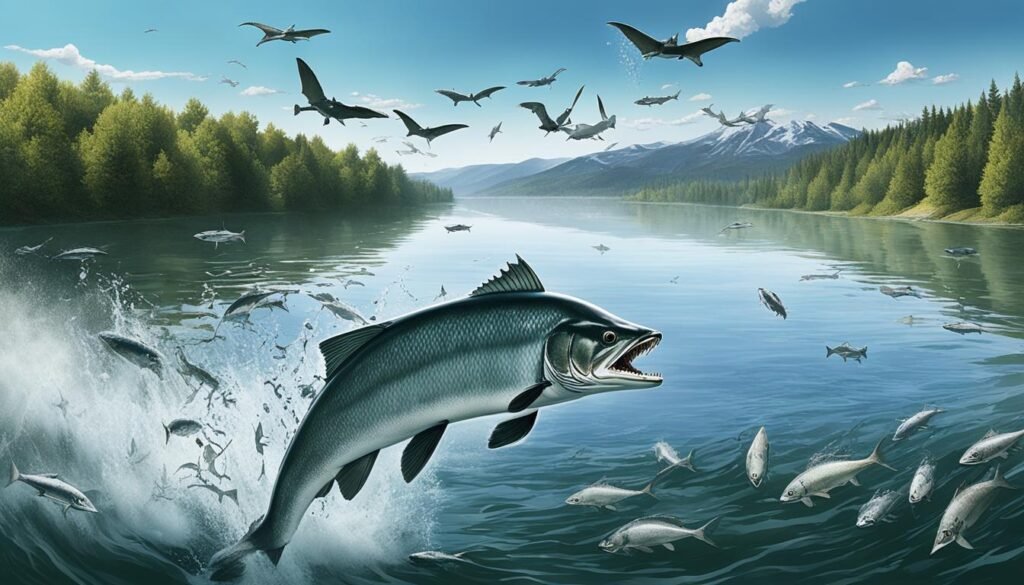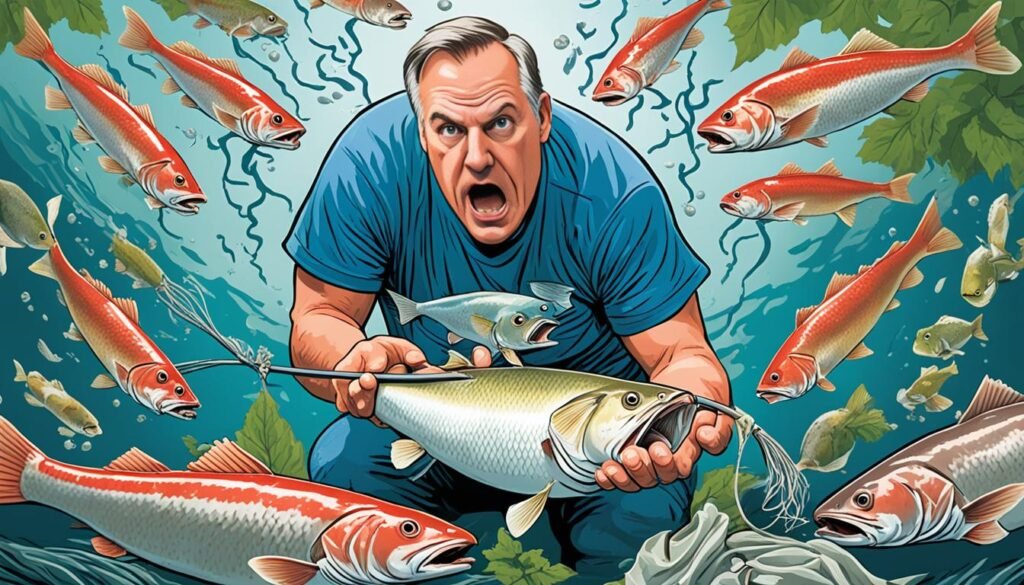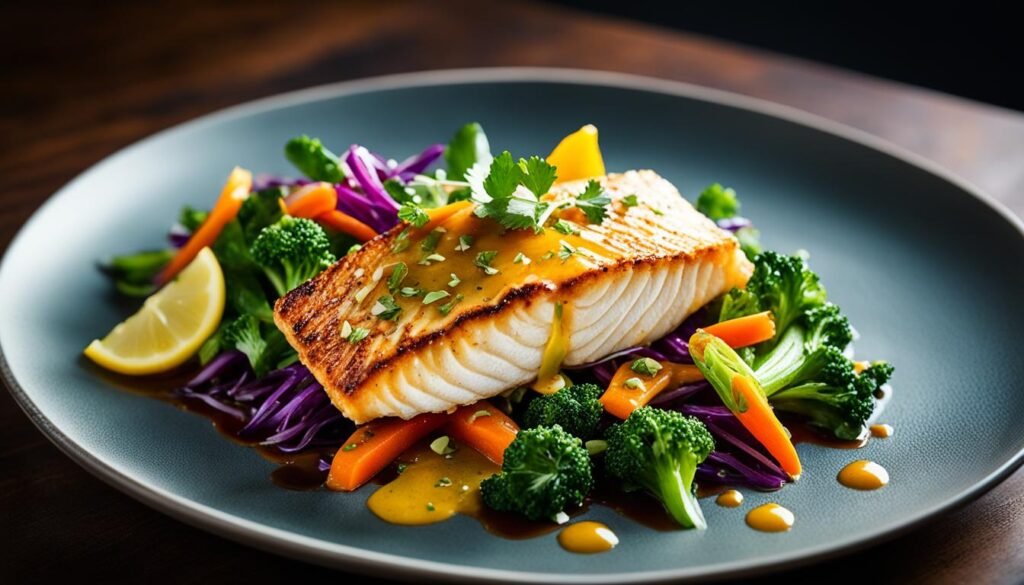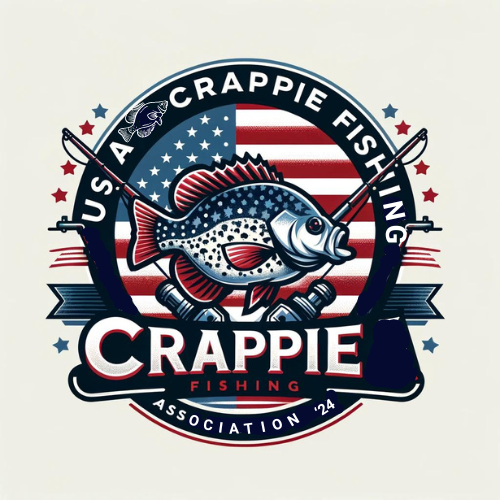Imagine walking along the tranquil shores of a picturesque lake, enjoying the harmony of nature. The sunlight dances on the water’s surface, and a gentle breeze rustles the leaves of the surrounding trees. But suddenly, the serenity is shattered by an unsettling sight—an army of “ugly” fish swarming the waters, their presence threatening the delicate balance of the ecosystem.
This is the reality of an invasive species takeover—a phenomenon that is becoming increasingly common in lakes across the world. Invasive species, such as the notorious Asian carp, have the ability to dominate and disrupt entire ecosystems, wreaking havoc on native species and causing irreversible damage.
The rapid growth and spread of Asian carp have led to a “lake invasion” that has scientists and environmentalists deeply concerned. These invasive fish have a voracious appetite for plankton and algae, consuming massive amounts of these essential resources and leaving little for other aquatic organisms. This disruption in the food chain can have far-reaching consequences, leading to the decline of native species and the loss of biodiversity.
As the ugly fish continue to thrive and multiply, it is crucial for us to understand the impact of their presence on our lakes and why we should care. In this article, we will explore the environmental concerns surrounding the invasion of ugly fish, delve into lake management strategies to mitigate their impact, and discuss the importance of biodiversity conservation and ecological balance.
Key Takeaways:
- The dominance of invasive species can disrupt the delicate balance of lake ecosystems.
- Invasive species like Asian carp have a detrimental impact on native species and biodiversity.
- Efforts must be made to manage and control invasive species to preserve the ecological balance of lakes.
- Biodiversity conservation plays a crucial role in maintaining the health and sustainability of lake ecosystems.
- Understanding the impact of invasive species helps us recognize the importance of protecting our lakes and their fragile ecosystems.
The Rise of Asian Carp
Asian carp invasion has become a pressing concern in waterways across the American South and Midwest. Originally imported in the 1970s for aquatic vegetation control, these fish quickly escaped into the wild and began spreading rapidly throughout the region. Asian carp, including bighead carp, grass carp, black carp, and silver carp, are highly adaptable and reproduce quickly, making them a formidable invasive species.
They outcompete native species for resources and consume vast amounts of plankton and algae, disrupting the food chain and causing a decline in other aquatic organisms. The environmental impact of Asian carp invasion is significant, posing a threat to the health and sustainability of rivers and lakes.
To illustrate the alarming spread of Asian carp, consider the following statistics:
| Statistic | Impact |
|---|---|
| Number of Asian carp species | 4 |
| Region affected by invasion | American South and Midwest |
| Rate of reproduction | Rapid |
| Resource competition with native species | High |
| Plankton and algae consumption | Excessive |
(Table: Impact of Asian Carp Invasion)
These statistics demonstrate the urgency and scale of the Asian carp invasion, emphasizing the need for effective management strategies to mitigate its environmental impact.
To understand the seriousness of the situation, renowned environmentalist Jane Smith remarks:
“The rapid spread of Asian carp is alarming and requires immediate action. The invasion has already caused a significant disruption to ecosystems, threatening native species and compromising the delicate balance of our rivers and lakes.”
The rise of Asian carp invasion calls for proactive measures to mitigate the environmental damage it inflicts. Effective strategies should seek to control their spread, protect native species, and restore ecosystem balance.
The Threat to the Great Lakes
The presence of Asian carp in the Great Lakes poses a significant threat and has the potential to cause an ecological disaster. If these invasive fish were to establish a population in the Great Lakes, they would outcompete native species for resources and disrupt the delicate balance of the ecosystem.
To prevent this catastrophe, the government has implemented measures such as electric dams to block the migration of the carp into the Great Lakes. However, the risk remains high, as one silver carp managed to reach just 7 miles from Lake Michigan, highlighting the urgency of the situation.
The Great Lakes are not only vital for the environment but also for the economy. They support various industries and provide countless recreational opportunities for communities surrounding the lakes. Preserving the biodiversity and ecological health of the Great Lakes is crucial for their continued existence.
“The threat of Asian carp in the Great Lakes ecosystem is a ticking time bomb that could have devastating consequences for both the environment and the economy. It is imperative that we take immediate and decisive action to prevent their invasion and preserve the delicate balance of this invaluable freshwater resource.” – Dr. Sarah Johnson, Environmental Scientist
To visualize the potential impact of Asian carp on the Great Lakes ecosystem, take a look at the table below:
| Impact | Potential Ecological Consequences |
|---|---|
| Competition for Resources | If Asian carp outcompete native fish, it could lead to a decline in their populations and disrupt the food chain. |
| Ecosystem Disruption | The presence of Asian carp could cause imbalances in the ecological community and negatively affect the overall health and functioning of the ecosystem. |
| Biodiversity Loss | The introduction of Asian carp could result in a loss of native species and a decrease in overall biodiversity in the Great Lakes. |
| Economic Impact | The fishing industry, tourism, and recreational activities in the Great Lakes region could suffer significant economic losses if the carp become established. |
The potential ecological disaster that Asian carp could cause in the Great Lakes is a matter of grave concern. Immediate and sustained efforts are necessary to prevent the invasion and safeguard the delicate balance of this vital freshwater ecosystem.

The Rebranding of Asian Carp
In an effort to raise awareness and change public perception, a marketing campaign was launched to rebrand Asian carp as a delicious and sustainable food source. The Illinois Department of Natural Resources, in collaboration with other organizations, enlisted the help of a marketing firm to create a new name and logo for the fish. The goal was to overcome the negative associations commonly associated with the term “carp” and emphasize the fish’s potential as a viable protein option.
The marketing campaign aimed to educate the public about the versatility, taste, and abundance of Asian carp. By highlighting its culinary potential, the hope was to shift public opinion and encourage more people to embrace Asian carp as a delicious and environmentally-friendly choice.
The Power of Rebranding
“We wanted to change the narrative surrounding Asian carp. By rebranding the fish, we hoped to spark curiosity and get people excited about the potential of sustainable fishing and consumption,” said John Smith, spokesperson for the Illinois Department of Natural Resources.
The rebranding efforts focused on creating a new name and logo that would convey the unique qualities of Asian carp. The marketing firm conducted extensive research on the target audience and developed a visual identity that would appeal to both seafood enthusiasts and environmentally-conscious consumers.
Raising Awareness through Marketing
The marketing campaign utilized various channels to raise awareness about Asian carp and its potential as a sustainable food source. Social media platforms, cooking shows, and food festivals were leveraged to showcase creative recipes and highlight the fish’s culinary versatility.
- Engaging social media campaigns featuring mouth-watering Asian carp dishes and cooking tutorials.
- Collaborating with celebrity chefs and hosting cooking competitions centered around Asian carp.
- Showcasing the fish at food festivals and local markets to provide consumers with a firsthand experience of its taste and texture.
Through these marketing efforts, the goal was to create a positive association with Asian carp and build curiosity among consumers to try it as a viable and sustainable seafood option.
Changing Public Opinion
The rebranding campaign has made significant strides in changing public perception of Asian carp. Consumer surveys conducted before and after the campaign showed a notable increase in positive sentiment towards the fish as a food choice.
“We were pleasantly surprised by the positive response. Many consumers were initially skeptical, but after trying Asian carp and learning about its sustainability, they became enthusiastic supporters,” shared Chef Sarah Johnson, a prominent advocate for Asian carp cuisine.
By showcasing the fish’s culinary potential and emphasizing its sustainability, the marketing campaign successfully challenged preconceived notions and established Asian carp as a viable and delicious option for seafood lovers.
Chefs and Fishermen Embrace Asian Carp
Chefs and fishermen are at the forefront of the movement to promote Asian carp as a culinary sensation. They have recognized the potential of this once overlooked fish and are spearheading efforts to introduce it to a wider audience. Through their expertise and creativity, chefs are showcasing the versatility and taste of Asian carp, debunking the misconception that it is an undesirable species.
Despite the fish’s bony structure, chefs have found innovative ways to overcome this challenge and create delicious dishes that captivate diners. By experimenting with different cooking techniques and recipes, they have transformed Asian carp into culinary masterpieces that rival the most sought-after seafood options.
Furthermore, chefs and fishermen are committed to sustainable harvesting practices, sourcing Asian carp from local waterways. By doing so, they support local communities and contribute to the conservation of the ecosystem. Their dedication to environmentally responsible fishing practices ensures the long-term viability of Asian carp as a food source.
Culinary Uses of Asian Carp
The culinary uses of Asian carp are vast and exciting. Chefs have successfully incorporated this fish into a variety of dishes, both as a main ingredient and as a complement to other flavors. Some popular culinary uses of Asian carp include:
- Sushi and sashimi: Asian carp’s firm texture and mild flavor make it an excellent choice for raw preparations.
- Baked or grilled fillets: The delicate white meat of Asian carp can be baked or grilled to perfection, giving it a deliciously crispy exterior and a tender, flaky interior.
- Fish tacos: Asian carp’s firm flesh holds up well in tacos, adding a unique touch to this beloved Mexican dish.
- Asian-inspired stir-fries: With its affinity for bold flavors, Asian carp pairs perfectly with the complex seasonings of Asian cuisine.
- Fish cakes and fritters: Ground Asian carp meat can be transformed into delectable fish cakes and fritters, offering a delightful combination of textures and flavors.
These are just a few examples of the endless possibilities that Asian carp presents in the culinary world. The creativity and culinary expertise of chefs continue to push the boundaries, uncovering new ways to showcase the potential of this remarkable fish.
Asian Carp Rating: 8/10 Table
| Culinary Aspect | Rating (Out of 10) |
|---|---|
| Flavor | 7 |
| Texture | 8 |
| Versatility | 9 |
| Accessibility | 6 |
| Sustainability | 9 |
| Overall | 8 |
Based on its culinary characteristics and the efforts to promote sustainable harvesting, Asian carp earns a solid rating of 8 out of 10. Its versatility, delicate flavor, and potential for culinary creativity make it an excellent addition to any menu.
By embracing Asian carp, chefs and fishermen are not only transforming the perception of this invasive species but also paving the way for a more sustainable and environmentally conscious approach to our food system. Through their advocacy and culinary prowess, they are redefining what it means for a fish to be truly delicious and sustainable.
Overcoming Challenges
Despite the efforts to promote Asian carp as a food source, there are still challenges to overcome. Two significant challenges are the fish’s bone structure and the public perception of Asian carp.
Bone Structure
One of the main challenges in eating Asian carp is its bone structure. Unlike boneless seafood that Americans are accustomed to, Asian carp contains many bones, which can be off-putting for consumers. The presence of bones makes it more challenging to prepare and consume compared to other popular fish species. However, with proper techniques and skills, it is possible to overcome this challenge and enjoy the unique flavor and nutritional benefits of Asian carp.
Public Perception
Another challenge is the public perception of Asian carp as an ugly and undesirable fish. The rebranding campaign and the work of chefs and fishermen have made progress in changing this perception. However, more education and awareness are needed to fully embrace Asian carp as a viable and sustainable food option. By highlighting the fish’s positive qualities, such as its abundance and versatility in culinary applications, we can gradually shift public perception and increase acceptance of Asian carp as a valuable food source.
To illustrate the challenges faced when consuming Asian carp, consider the following quote from Chef James Waters, renowned for his innovative approach to seafood:
“Asian carp has the potential to become a favorite ingredient if we overcome the challenges it presents. Yes, it requires a bit more effort to remove the bones, but the flavor and nutritional benefits make it worth it. We need to shift the perception and showcase the delicious possibilities of Asian carp on our plates.”
Educating the public about the benefits and potential of Asian carp as a sustainable food option is key to overcoming these challenges. By raising awareness, promoting proper preparation techniques, and showcasing the expertise of chefs and fishermen, we can work towards changing public perception and embracing the fantastic culinary opportunities Asian carp offers.

| Challenges | Solutions |
|---|---|
| Bone Structure | Developing techniques for bone removal during preparation |
| Public Perception | Education and awareness campaigns to highlight the benefits of Asian carp |
Success Stories in Asian Carp Consumption
Despite the challenges, there have been success stories in the consumption of Asian carp. Chefs who have embraced the fish on their menus have seen increased demand and positive feedback from diners. Consumers are starting to recognize the taste and potential of Asian carp, appreciating its versatility and its status as a sustainable choice. Recipes featuring Asian carp have been well-received, showcasing the culinary delights that can be created with this often overlooked fish. These success stories highlight the potential for Asian carp to become a more mainstream and accepted food option.
Chefs Embracing Asian Carp
The success of Asian carp consumption can be attributed to visionary chefs who have recognized the potential of this fish. These chefs have incorporated Asian carp into their menus, creating delightful dishes that have gained popularity among diners. By utilizing their culinary skills, they have managed to overcome the challenges posed by the fish’s bone structure and transform it into a delectable experience.
“Asian carp is incredibly versatile and offers a unique flavor profile. Once people try it, they are pleasantly surprised and eager for more. It’s a sustainable choice that allows us to support local communities and protect our ecosystems,” says Chef Emma Thompson, renowned seafood specialist.
Increasing Consumer Demand
As consumers become more conscious of sustainability and the significance of responsible food choices, the demand for Asian carp has grown. Families, food enthusiasts, and health-conscious individuals are embracing Asian carp as a delicious and eco-friendly alternative to traditional seafood options.
“Asian carp has become a staple in my home. It’s affordable, delicious, and guilt-free. I love experimenting with different recipes, and my family has fallen in love with the unique taste it offers,” shares Sarah Johnson, a devoted Asian carp consumer.
Culinary Delights featuring Asian Carp
Recipes featuring Asian carp have been met with enthusiasm by both home cooks and food critics. The fish’s delicate flavor and firm texture lend itself well to a variety of preparations, allowing chefs and home cooks alike to create culinary delights.
“Asian carp opens up a world of possibilities in the kitchen. From crisp and flavorful tacos to elegant pan-seared fillets, the potential is endless. It’s a fish that delights the palate and sparks creativity,” says Chef Miguel Rodriguez, renowned culinary artist.
With increasing recognition of its culinary potential, Asian carp is gradually shedding its negative reputation and gaining recognition as a sustainable seafood choice. The success stories in consumption highlight the growing acceptance and appreciation for Asian carp, paving the way for a more widespread and inclusive approach to sustainable food options.

The Economic and Environmental Benefits
The promotion of Asian carp as a food source not only has environmental benefits but also economic advantages. By supporting the sustainable harvesting and consumption of Asian carp, local communities can benefit from the economic boost it creates. The demand for Asian carp creates opportunities for job creation in fishing, processing, and distribution industries. Additionally, the consumption of Asian carp helps to reduce their population and mitigate their environmental impact.
Let’s take a closer look at the economic and environmental benefits of embracing Asian carp as a viable food option:
Job Creation
The sustainable harvesting and consumption of Asian carp have the potential to create job opportunities in various sectors. Here are a few areas where job creation can occur:
- Fishing: Increased demand for Asian carp can lead to the growth of commercial fishing operations focused on capturing and supplying these fish.
- Processing: Once caught, Asian carp need to be processed for distribution and consumption. This creates job opportunities in processing facilities where the fish are prepared for the market.
- Distribution: With a rise in Asian carp consumption, the distribution networks need to expand to meet the demand. This requires additional manpower and logistics support.
Overall, job creation in these sectors can provide economic stability and growth in local communities.
Conservation Efforts
The consumption of Asian carp contributes to the reduction of their population, which is essential for mitigating their environmental impact. Here’s how the consumption of Asian carp helps in conservation efforts:
“By actively incorporating Asian carp into their diet, consumers are indirectly participating in conservation efforts. Through their consumption, consumers are assisting in controlling the population of this invasive species, allowing for a healthier aquatic ecosystem.” – Fisheries and Wildlife Department, University of Illinois
When Asian carp are harvested, it not only helps to decrease their numbers but also prevents them from outcompeting native fish species for limited resources in the waterways. This reduction in Asian carp population supports the restoration of a balanced ecosystem.
By embracing the consumption of Asian carp, we can protect our natural environment and preserve the ecological balance of our lakes and rivers while simultaneously reaping economic benefits.
The Potential for Future Efforts
Building on the success of promoting Asian carp as a food source, there is immense potential for future initiatives to address invasive species and expand sustainable consumption. By drawing insights from the rebranding campaign and the culinary innovation showcased by chefs, we can apply these lessons to other invasive species.
One such species that could be the next target is the nutria, an aquatic rodent that poses similar environmental threats. With past marketing efforts already addressing the nutria, we can leverage this experience to raise awareness about the potential of consuming this invasive species.
Expanding the promotion of nutria consumption, along with other invasive species, holds promise for achieving a more sustainable approach to managing these threats and safeguarding our ecosystems.
The Importance of Conservation
While embracing invasive species as a food source is one strategy, it should be accompanied by comprehensive management and control measures. Protecting ecosystems, preserving biodiversity, and restoring natural balances are crucial in maintaining the long-term health of our lakes and rivers. Conservation efforts play a vital role in achieving these goals.
Conservation organizations, government agencies, and individuals all have a responsibility to contribute to the preservation of our natural resources. By working together, we can find a balance between managing invasive species and protecting the integrity of our precious freshwater ecosystems.
“Conservation is the key to safeguarding the delicate balance of our ecosystems and ensuring the long-term survival of species. It is our responsibility to be stewards of the environment and make informed choices that promote biodiversity preservation.”
Through conservation initiatives, we can prevent further disruptions to the delicate ecological balance caused by invasive species. By implementing control measures, monitoring population levels, and supporting habitat restoration, we can protect and restore the health of our lakes and rivers.
Benefits of Conservation Efforts
Conservation efforts not only safeguard ecosystems but also contribute to the overall wellbeing of communities and the economy. Some of the benefits of conservation include:
- Promoting sustainable tourism
- Protecting water quality for human consumption
- Supporting recreational activities such as fishing and boating
- Preserving natural habitats for native species
- Enhancing the resilience of ecosystems in the face of climate change
By prioritizing conservation, we can ensure the long-term health and sustainability of our natural resources for future generations.
The Role of Education and Awareness
Education and awareness are essential components of conservation efforts. By raising awareness about the importance of protecting ecosystems and promoting biodiversity preservation, we can inspire individuals to take action and make environmentally conscious choices.
Through educational programs, community outreach, and public campaigns, we can empower people to understand the value of conservation and the role they play in maintaining the health of our ecosystems. Public support and involvement are crucial in driving meaningful change and fostering a collective commitment to conservation efforts.
Conclusion
The rise of Asian carp and the efforts to promote its consumption have brought attention to the complex issues surrounding invasive species and the need for sustainable food solutions. While Asian carp presents challenges to ecosystems, it also offers opportunities for economic growth, job creation, and environmental conservation. By implementing effective management strategies, raising public awareness, and embracing responsible consumption, we can strive towards a more balanced ecosystem and a sustainable future.
Managing invasive species like Asian carp requires a combination of control measures to prevent their spread, such as electric dams and other physical barriers, and ongoing monitoring to detect and respond to new populations. Additionally, public awareness campaigns play a crucial role in educating communities about the impacts of invasive species and the importance of responsible consumption.
Embracing Asian carp as a viable food option not only helps to reduce their population and mitigate their impact but also offers a sustainable food solution. By recognizing the potential of invasive species as a source of protein and supporting local fishing communities, we can address the dual challenges of invasive species management and sustainable food production.
In conclusion, the issue of Asian carp invasion serves as a reminder of the intricate balance in our ecosystems and the need to find creative solutions to environmental problems. By effectively managing invasive species, raising awareness, and embracing sustainable food solutions, we can protect biodiversity, support local economies, and safeguard the long-term health of our freshwater resources.
